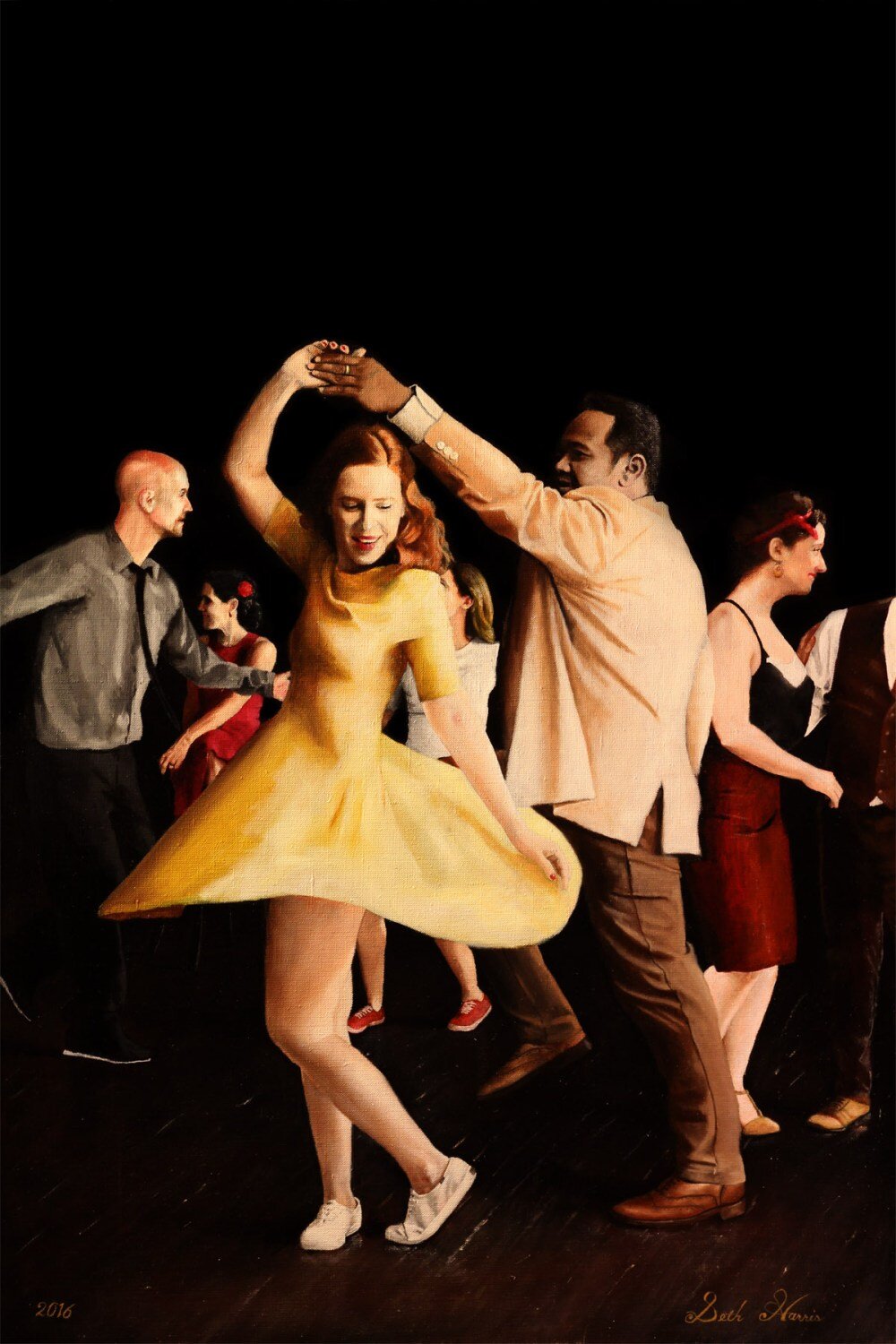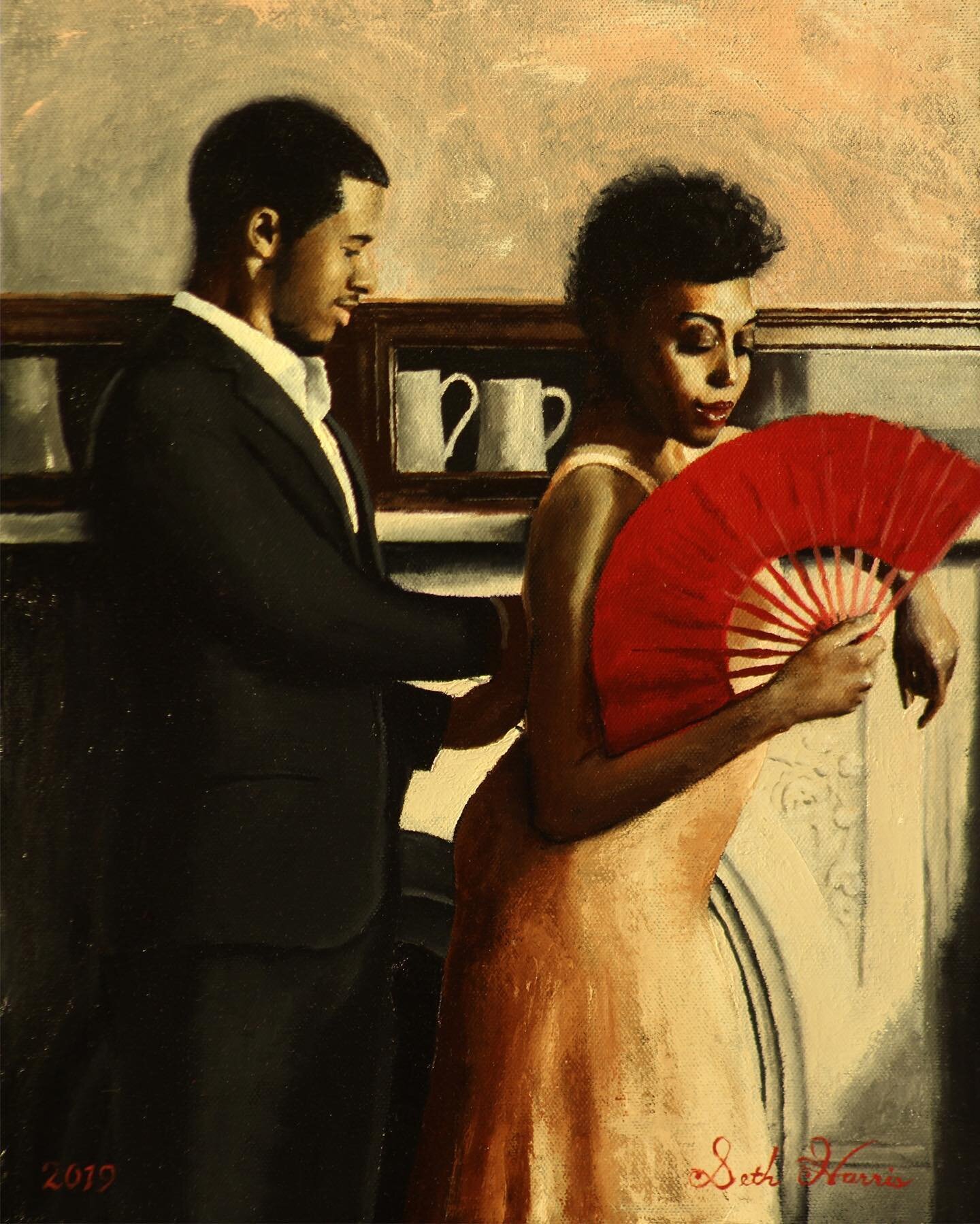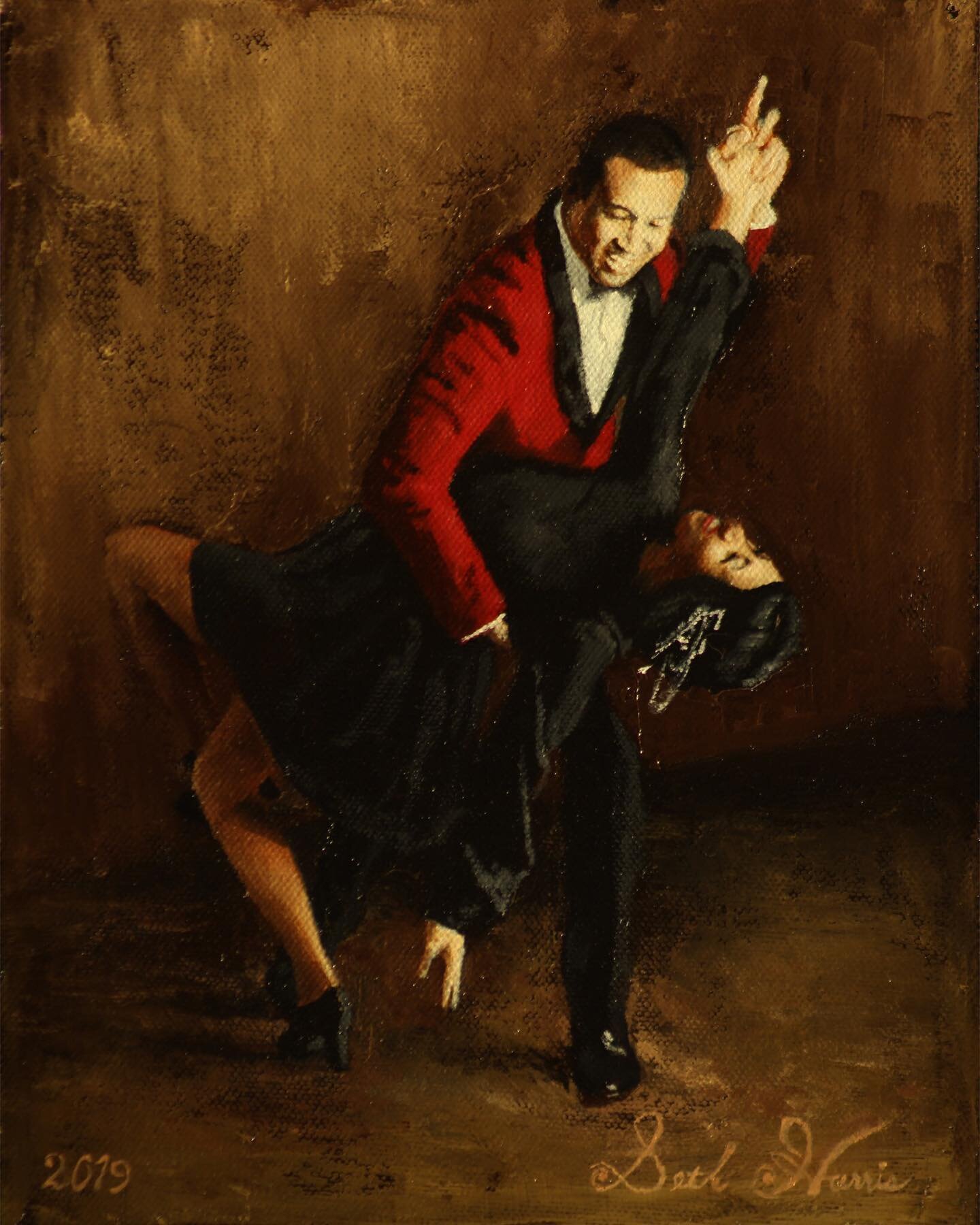Motion & Emotion Captured on Canvas: The Swing Dance Paintings of Seth Harris

Motion & Emotion Captured on Canvas: The Swing Dance Paintings of Seth Harris
By Sharon M. Chin
American oil painter, Seth Harris, is both painter and swing dancer. His painting, “End of Song,” showcases his keen eye and firsthand dance perspective in capturing the fleeting motion and emotion of swing dancers. As a song’s end approaches on a dance floor, there is an ephemeral moment when bodies unconsciously start to savor and embody the last notes of the music. Some partnered pairs end with dramatic flourishes- deep dips and unexpected lifts- and others pose as if static sculptures- faces etched with joy, delight, or gratitude at the wonder of partnership and musicality. And with “End of Song,” Seth vibrantly captures three swing dance couples in this transitory moment, intimately drawing the viewer into the dancers’ world on canvas.
Dancing since 2015 and painting since 2006, Seth Harris has created over 30 paintings devoted to present-day NYC swing dancers. Seth’s paintings capture motion on the dance floor, realistically evoking figures, feelings, and flow. And while Seth takes inspiration from real moments and studies of swing dancers, his paintings are composed crafts, reflecting his impressions, storytelling, and creative agency. For example “End of Song” is a composite figural painting of three separate partnered figure studies, based on 4-5 photos each, and is imaginatively composed into a single setting. Seth notes “the arrangement is set with respect to cohesion and the viewer’s gaze through use of the golden ratio and Fibonacci spiral.” His vivid and dramatic swing paintings, with their authentic capture of swing dancers and the swing dance experience, are on view this month in a December 6th solo show with Brooklyn Swings, appropriately paired with a swing dance party, and with select works at the National Arts League and Salmagundi Club.
Seth’s swing dance oil painting present an immersive introduction to individuals in NYC’s current swing dance scene. Whether capturing recognizable individuals social dancing, in a pre-performance setting, or just lounging together at the beach, with a warm palette and rough texture, Seth captures each individual recognizably and realistically. With almost photographic-quality physical features, Seth is also uncanny in his capture of dancer personalities; One observer noted “I can hear Lainey laugh or feel Lalaina’s energy when I see Seth’s work. I recognize Margaret and countless others immediately.” Seth finds joy in painting the swing dance community, noting “it filled with kind and inspiring people. And I think of my dancing and painting often in terms of relationships; whether it’s a song with a dance partner or 30-100 hours with my painting, at the end of the day, I have learned more about my subject and myself. When I dance with someone, and then paint that person, it’s a continuation of that relationship.” And if dancing is as much a learned art through the eye as the body, Seth’s observant eye allows him to capture the essence of each person he paints on the dance floor.
Seth is a self-taught artist who began his craft while at sea. After earning a degree in naval architecture, Seth became a merchant marine and spent five years living on boats. Working more than 80 hours a week and on a boat for six months each year, Seth adopted watercolor painting as a way to “stay sane while shipping. I was very busy but art made me feel free. I chose watercolors because I could drop and set it down at a moment’s notice.” And while Seth eventually disembarked from a sailor’s life, painting stayed with him. Transitioning to a land job, Seth “felt like a fish out of water,” and his paintings “began to reflect subjects in unnatural habits.” Seth became obsessed with painting mermaids, “land mermaids specifically. I’d paint mermaids on land- for example, a mermaid on the subway-and I became fascinated at seeing the potential for magic among the mundane.” This series, using pen, ink, and watercolor, was noticed by Brooklyn arts house and instrumental in Seth’s transition to oil painting.
At the arts house, Seth had a residency, his first solo show, and art print sales. Seth, feeling emboldened, less like a hobbyist and more like an artist, felt ready to experiment with oils. “For a long time, oils were daunting to me. I thought I could only do watercolor because I am color blind- red and green blind specifically. With water colors, I felt safe- there’s no risk of blending and painting over my own colors.” Seth, given courage by the residency, began to dabble with oils and in 2015 realized “I could achieve my impact with painting with only half the color spectrum- choosing black and white, yellow, orange, and red. I find the colors to be so evocative that I don’t feel limited by a limited palette.” Seth notes “I am also fascinated by the beach and beachgoers as a subject. In my beach paintings, I often paint the sea but there’s no blue at all. I use grey for sky and sea and people think the blue is there, but it’s a trick because the rest of the painting is so warm.”
With a painting style somewhere between an impressionist and a realist, the creative process for Seth’s dance paintings currently begins with a photographic study followed by creative license. Seth thoughtfully stated “To be a good painter, you have to figure out how to avoid being a slave to reality. I firmly believe in my role as a composer and in embracing art with both mistakes and imagination.” Seth’s creative process begins with a photoshoot focused on capturing the “striking” moment from his subject. He then chalks an impressionist sketch of the moment, makes physical notes on a printed out photo to mark desired embellishments and alterations, and finally proceeds with color. For example, Seth may change a dress from a cotton fabric to a rich orange silk, obscure parts of the image in darkness, or allow for a doppelganger of a subject to appear twice in order to alter the painting’s mood or the viewer’s gaze. Seth paints in the spirit of the painting adage where “a painter paints not what he sees, but what he feels, and what he tells himself about what he has seen.”
A View of Seth Harris’s Studio
A Collection of Swing Paintings Prior to Gallery Presentation
Seth uses painting as storytelling and “he wants people to feel the conversation and memory that I had with the subject. And swing is particularly powerful for the feelings it evokes in me, as both a dancer and a member of this community, and the passionate people which partake in it.” Seth invokes the attributes of sight, from darkness, light, color, form, position, motion, and rest to drive his storytelling but also relies heavily on the invisible attributes of cathartic emotion. And luckily for members of the swing dance community and outside observers, Seth’s work is realistically striking, capturing the transient motion and emotion of swing dancers vividly on the painted canvas.
More From Seth Harris
Where Can We See You Next: “Catch me at Brooklyn Swings on December 6th. I also have three pieces at the National Art League till January 4th and I have one piece at the Salmagundi Club till January 1st. The National Art League is showing: "Girl with Orange", "Black and White Suits", and a new charcoal called "Black Gloves." The Salmagundi Club is showing: "Lalaina and Mianja." Follow me for future shows, including another swing focused show in October 2020 in Rehoboth, Delware.”
Who Are You Watching: “I love the work of Joseph Lorusso. I haven't seen one bad painting from him. His composition is so warm and dreamy, it's like looking at a happy memory.”
What Work Are You Most Proud of: “There’s a painting of Briana [my wife] and I dancing beneath the arches of the great hall at the Metropolitan Museum of Art. I’m in the work but I’m not interesting as a subject, so my presence is there but obscured. This piece, from architecture, my wife, to dancing, is full of things I love. I spent over 100 hour on this painting and it’s probably the reason why I had to retake my Professional Engineering exam- a labor of passion, I spent so much time on it.”
Advice for other Painters: “Oooh. This is tough. Everyone paints for a different reason. To Painters in general I would say, "Experiment and figure out for yourself what works." To Painters who specifically like my work, I would say, "Steal as much of my technique and process as possible and then do your experiments so that you can make it better than I did."
What’s One Art Story that Has Captured Your Imagination: “I'm going to have to give a lame answer and say that I just watched season 4 episode 1 of BBC’s documentary drama series "Fake or Fortune." Americans don't give much thought to Lowery but I really enjoyed this episode, which dealt with the forensic work that went into the authentication process of three early works reported to be his.”
What’s One Fun Fact About You: “I was a background actor in this current season of "The Marvelous Mrs. Maisel". So when season 3 premieres, you can get your magnifying glass' out and try to spot me dressed up as a 1950's soldier.”
















